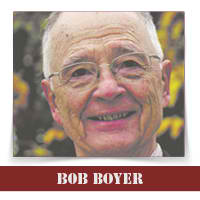
By: Bob Boyer
I recently received a note from my friend Vicky, a former student and, later, a professional colleague of mine. I had gifted her with a copy of Sundays in Manila, the book I had written about some of my experiences while an Exchange Professor at the University of the Philippines Diliman in Manila. Vicky had promised to let me know what she thought of the book. I was not surprised with her reaction, especially knowing that her husband is a Vietnam War Veteran.
“Forgive me for being delinquent in expressing my delight at reading Sundays in Manila. It is easy to see why it has sold so well, even in Manila. Reading it, I feel as though I now know personally the people you describe; I feel as though I am riding on that bus with you to your various destinations. My husband is in the habit of comparing arduous undertakings to the Bataan Death March, so your chapter on Bataan was fascin ating. I enjoyed traveling with you, being your companion, enjoying the surprises right along with you. It was a treat!”
Vicky’s comment about the Bataan Death March rekindled memories of my visit to Bataan and what I wrote about it afterward. Memorial Day Weekend has just passed, but some events, such as the Bataan Death March, merit our special and ongoing attention. The following are highlights of “Bataan” from Sundays in Manila.
“For me this trip had been long in coming. I was six years old in October of 1943, when the long-delayed news of the atrocities of the Bataan Death March broke. So shocking were those events that the US government had suppressed news of what happened in April of 1942 in Bataan as long as they could (a year and a half) for fear that a public outcry would require it to change its “Europe First” policy. But the lid came off when some Americans . . . managed to escape, with help from Filipinos, after having endured the Death March and a year or more of internment. I have never forgotten the outrage I sensed everywhere I turned. Bataan awoke my consciousness to World War II . . . .”
“The Death March lasted seven days. Because of the conditions of the POWs and the brutal treatment by the Japanese, casualties along the way were high. If a soldier fell and couldn’t get up on his own or with help from slightly stronger comrades, he was bayoneted. In a fairly recent (2003) account of the first year of war and occupation, Filipino Benito J. Legarda Jr. indicates that the Japanese stopped any civilians who attempted to help. Legarda also notes that the Japanese refused the request of General King, the officer of record who surrendered to the Japanese, to convoy the men in available surrendered vehicles.”
“Legarda’s conservative calculation is that between 600 and 650 Americans and between 5,000 and 10,000 Filipinos died along the way. Donovan Webster puts the combined Philippine-American death toll on the march at 11,000. He also estimates that an additional 1500 Americans and 20,000 Filipinos died during the first three months of internment. That would mean that of the more than 79,000 troops—approximately 58,000 Filipinos and 12,000 Americans—that were surrendered on April 9, 1942, about 36,000, barely more than half, were still alive after the seven-day march and three months of harsh imprisonment.”
“Some of these thoughts, in less defined form, were going through our minds as my companions and I joined about a dozen others in walking about the small park. A few other objects, in addition to the KM00 marker, now attracted our attention. An elongated mound occupies a considerable portion of the approximate center of the park. Near one end of the mound is what appears to be a temporary identification sign, declaring this to be the ‘Starting Point of Death March, April 9-17, 1942, KM00, Mariveles, Bataan. . . . Beyond the mound Philippine and American flags stand side by side in front of a wall containing two large bronze plaques that provide some of the basic information about the Death March.”
“We lingered in the park. . . . We spoke little, and when we did it was in low tones. I was reminded of visiting the family cemetery on Memorial Day, with the usual mixture of emotions that event evokes: sadness, curiosity, and speculation. And, again, we felt a sense of awe at the size and scope of what had occurred here.”
Bob Boyer welcomes your observations and questions at Robert.boyer@snc.edu.
 VIA Times – June 2022 Issue Vital News, Vibrant VIews for Asian Americans in Chicago & Midwest
VIA Times – June 2022 Issue Vital News, Vibrant VIews for Asian Americans in Chicago & Midwest

